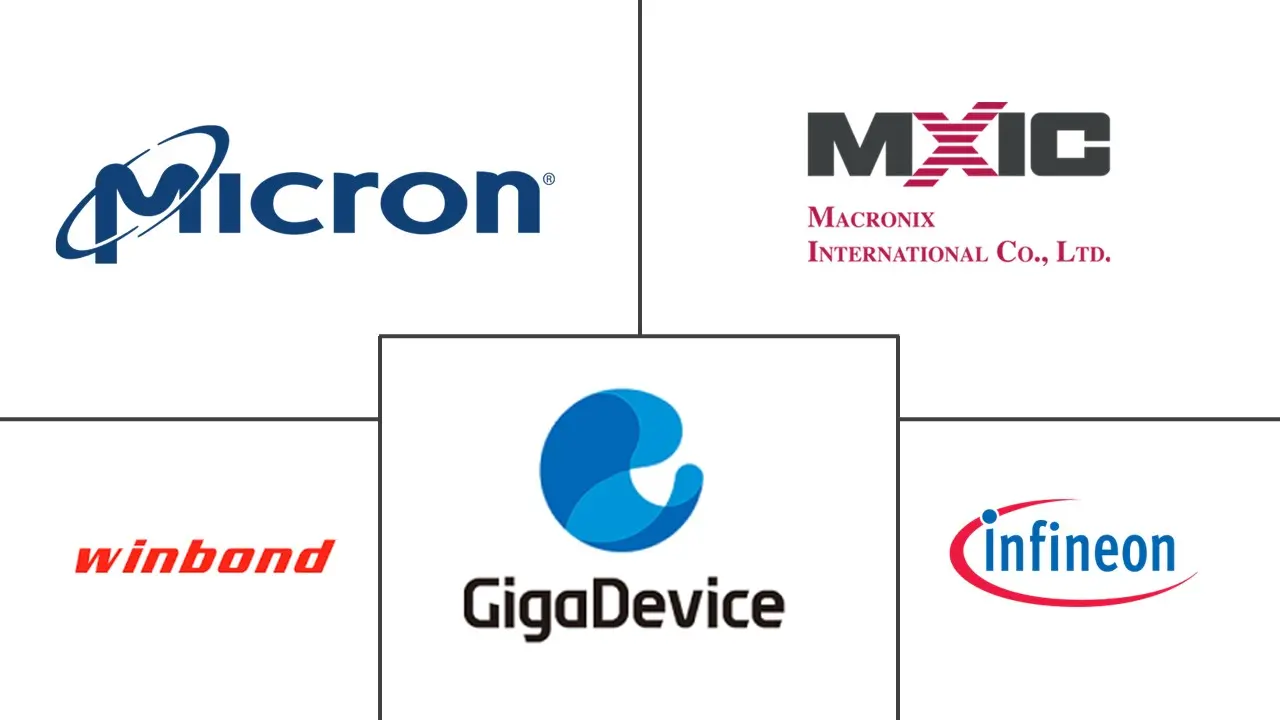Europe NOR Flash Market Size and Share
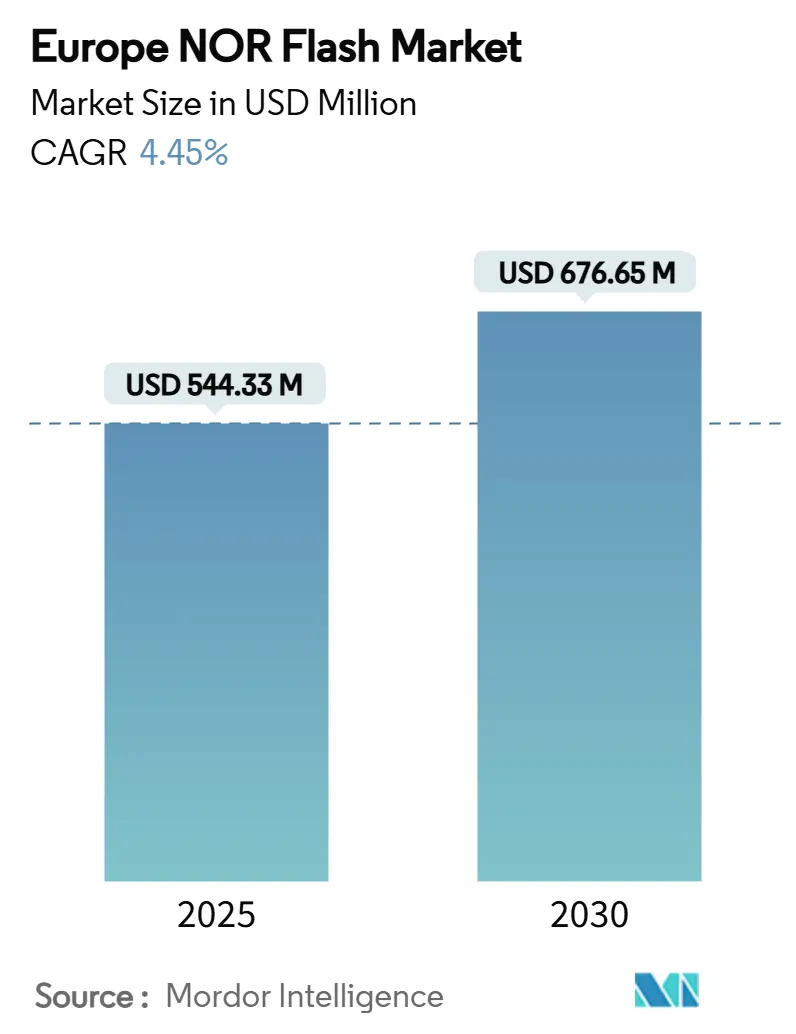
Europe NOR Flash Market Analysis by Mordor Intelligence
Europe NOR Flash market size stands at USD 544.3 million in 2025 and is forecast to reach USD 676.65 million in 2030, expanding at a 4.45% CAGR during the forecast period. Rising semiconductor content in vehicles, stringent functional-safety mandates, and expanding edge-AI deployments in industrial control systems underpin the demand curve. Serial devices remain the preferred choice as OEMs prioritize low pin-count and compact PCB layouts to trim assembly cost. High-density parts above 256 Mb are growing fastest thanks to software-defined vehicles that require secure over-the-air code storage. Investments enabled by the EU Chips Act are also strengthening local supply resilience and compressing time-to-market for European original-equipment makers.
Key Report Takeaways
- By type, Serial NOR dominated with 70.8% revenue share in 2025, while Parallel NOR is constrained to a 3.1% CAGR through 2030.
- By interface, SPI Single/Dual led with 66.7% of the Europe NOR Flash market share in 2025; Octal and xSPI is projected to expand at a 5.2% CAGR to 2030.
- By density, the greater than 256 Mb class commanded 5.6% CAGR, whereas 8 Mb and less captured 28.3% of the Europe NOR Flash market size in 2025.
- By voltage grade, 3 V devices held a 57.5% share, while 1.8 V components are advancing at a 5.1% CAGR.
- By process node, 55/58 nm accounted for 35.7% revenue in 2025; 28 nm and below is the fastest-growing node at 5.2% CAGR.
- By packaging, QFN/SOIC formats led with 46.7% share; WLCSP/CSP is rising 5.4% CAGR on IoT miniaturization.
- By end-user, automotive captured 38.8% of the Europe NOR Flash market size in 2025; medical and wearables are climbing at a 5.3% CAGR.
- By country, Germany led with over 20% share in 2025; Rest of the Europe countries is pacing ahead at 5.4 % CAGR.
Europe NOR Flash Market Trends and Insights
Drivers Impact Analysis
| Driver | % Impact on CAGR Forecast | Geographic Relevance | Impact Timeline |
|---|---|---|---|
| Automotive OEM-mandated Flash Quality Targets Driving Design-ins in Germany and Nordics | +1.60% | Germany, Nordics, France | Medium term (2-4 years) |
| EU Data-centric Edge-AI Roll-outs Elevating Serial NOR Adoption in Industrial PLCs | +1.10% | Germany, France, Italy, Benelux | Medium term (2-4 years) |
| Shift to OTA Firmware Updates in European EVs Boosting High-Density SPI NOR Demand | +0.90% | Germany, UK, France, Nordics | Short term (≤ 2 years) |
| Telecom Open-RAN Deployments in UK and France Requiring Low-latency Boot Code Storage | +0.70% | UK, France, Spain | Medium term (2-4 years) |
| Medical-grade Wearables Regulation (MDR) Accelerating Secure NOR Integration | +0.40% | Germany, Nordics, Benelux | Short term (≤ 2 years) |
| EU Chips Act Funding for 28 nm and 45 nm NOR Lines (e.g., Dresden) | +0.20% | Germany, France, Italy | Long term (≥ 4 years) |
| Source: Mordor Intelligence | |||
Automotive OEM-mandated Flash Quality Targets Driving Design-ins in Germany and Rest of the Europe
German and Rest of the Europe carmakers now require ASIL-D certified flash for safety-critical ECUs. Infineon’s SEMPER portfolio met that bar in 2025, signaling a design-win flywheel for memory vendors that can guarantee zero-defect quality and long product lifecycles [1] Infineon Technologies AG, “Infineon SEMPER™ NOR Flash Memory family achieves ASIL-D certification,” infineon.com . Suppliers able to validate to SGS-TÜV standards are capturing premium pricing. The policy also spills into industrial robotics, where functional safety architectures mirror automotive practice. As the mandate cascades through tier-1s, it lifts value per vehicle and protects margins against cheaper NAND substitutes.
EU Data-centric Edge-AI Roll-outs Elevating Serial NOR Adoption in Industrial PLCs
The Commission’s data-sovereignty agenda is shifting analytics to the factory floor. Infineon’s PSOC Edge MCUs, integrating NVIDIA TAO models, exemplify the platformisation of AI at less than 2 W power budgets [2] Infineon Technologies AG, “Infineon advances Edge AI computing on PSOC™ Edge,” infineon.com . Industrial designers specify fast, low-pin Serial NOR to store and execute AI inference models near sensors, avoiding latency imposed by cloud round-trips. Demand accelerates in automotive stamping and chemical plants first, then diffuses across food processing and discrete manufacturing.
Shift to OTA Firmware Updates in European EVs Boosting High-Density SPI NOR Demand
Software-defined vehicles rely on dual-bank, high-density SPI NOR to deliver secure, line-rate updates. Post-quantum signature schemes such as CRYSTALS-Dilithium inside AUTOSAR increase code payloads, nudging demand for greater than 512 Mb parts [3] Joppe W. Bos et al., “Post-Quantum Secure Over-the-Air Update of Automotive Systems,” eprint.iacr.org . Early adopters include German premium EV brands that view zero-downtime updates as a customer-experience differentiator. Memory vendors capable of automotive-grade secure-boot stacks are therefore gaining preferred-supplier status.
Telecom Open-RAN Deployments in UK and France Requiring Low-latency Boot Code Storage
Vodafone, Orange, and Telefónica are de-risking vendor lock-in by standardising on Open RAN. Baseband cards require deterministic boot code held in low-latency NOR rather than commodity NAND, particularly in remote rural cell sites where cold-start times are critical [4] Microchip Technology Inc., “Guide to Commercially Available Open RANs,” microchip.com . Initial roll-outs centre on the UK and France, then scale to Spain, stimulating incremental orders for industrial-temperature NOR grades.
Restraints Impact Analysis
| Restraint | % Impact on CAGR Forecast | Geographic Relevance | Impact Timeline |
|---|---|---|---|
| Rising 1.8 V NAND substitutes below 256 Mb in Consumer IoT Nodes | -0.70% | UK, France, Germany, Italy | Short term (≤ 2 years) |
| Fab-level Yield Losses on 28 nm Floating-Gate Nodes Elevating ASP Volatility | -0.40% | Germany, France | Medium term (2-4 years) |
| Tight Allocation of Specialty Photomasks in Europe Hindering Parallel NOR Expansion | -0.20% | Germany, France, Italy | Medium term (2-4 years) |
| Post-Brexit Customs Delays Impacting Lead-times for UK Automotive Tier-1s | -0.20% | UK | Short term (≤ 2 years) |
| Source: Mordor Intelligence | |||
Rising 1.8 V NAND substitutes below 256 Mb in Consumer IoT Nodes
For cost-sensitive consumer IoT nodes, Micron’s 1 Gb SPI NAND narrows the read-latency gap while halving BOM cost [5] Micron Technology, “1 Gb SPI NAND Flash Memory – Features,” farnell.com . European white-goods makers are therefore specifying NAND below the 256 Mb threshold, eroding NOR volume at the low end. NOR suppliers respond by sharpening value propositions around execute-in-place and security that NAND struggles to match.
Fab-level Yield Losses on 28 nm Floating-Gate Nodes Elevating ASP Volatility
Floating-gate NOR at 28 nm faces defect-density hurdles unfamiliar in bulk-logic fabs, pushing average-selling-price volatility. European fabs in Dresden and Crolles report yield ramp delays that constrain the supply of high-performance parts, especially for mission-critical ADAS workloads. EU Chips Act subsidies help offset capital risk, but process learning curves remain a brake on output.
Segment Analysis
By Type: Serial NOR secures the cost-down advantage
Serial devices accounted for 70.8% of the Europe NOR flash market in 2024. Lower pin counts translate into smaller board footprints and simplified routing, attributes that resonate with automotive telematics and industrial HMIs. The GD25/55 family from GigaDevice, certified to ISO 26262:2018 ASIL-D, underlines the safety-first evolution now baked into serial offerings [6] GigaDevice, “Embedded World: GigaDevice Showcases Advances in Flash and MCU Technologies for Edge AI, Green Energy, Automotive and IoT,” sttinfo.fi . Serial units, therefore, anchor the bill-of-materials for mass-market dashboards, power-train controllers, and smart meters.
Parallel NOR is used mainly in high-reliability legacy boards that still need 16- or 32-bit data buses. However, its appeal erodes as system architects migrate to xSPI-compliant serial parts that deliver near-parallel throughput without the space penalty. The Europe NOR flash market is thus expected to retire several parallel product lines as serial hosts become ubiquitous on automotive and industrial MCUs.
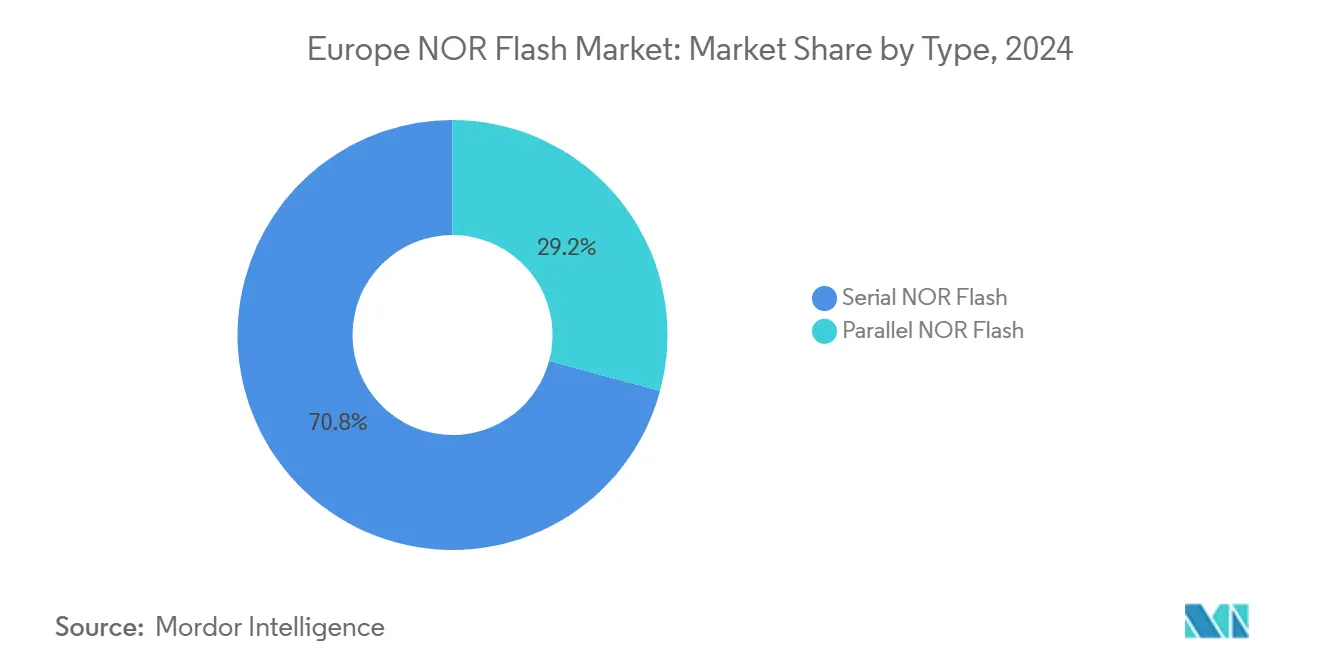
By Interface: SPI mainstream, Octal accelerates performance roadmap
SPI Single/Dual interfaces represented 66.7% revenue in 2024 because they remain plug-and-play across entry-level MCUs. Despite its maturity, SPI continues to evolve; Winbond has proven 133 MHz operation for Quad SPI, extending life span without redesign effort [7]Winbond Electronics, “Serial NOR Flash Memory – Code Storage Flash Memory,” winbond.com .
Octal and xSPI devices booked the fastest 5.2% CAGR, leveraging 8-byte parallelism to push 500 MB/s reads in Macronix’s OctaFlash series.[8] Macronix International, “OctaBus Memory,” mxic.com.tw The Europe NOR flash market size attached to Octal parts is forecast to grow significantly as infotainment domain controllers and ADAS-centric SoCs demand DDR-grade bandwidth.
By Density: high-density surge mirrors software-defined mobility
Segments up to 8 Mb contributed 28.3% of the Europe NOR flash market size in 2024. They remain indispensable for boot code and small RTOS images in industrial drives. Yet vehicles’ codebases are ballooning. Devices above 256 Mb are therefore pacing at 5.6% CAGR, reflecting the rise of consolidated zonal ECUs. Infineon’s 512 Mb CYRS17B512, based on 40 nm SONOS, is tailored for execute-in-place use cases such as cluster displays [9] Infineon Technologies AG, “CYRS17B512 – 512 Mb Serial NOR Flash Memory,” infineon.com .
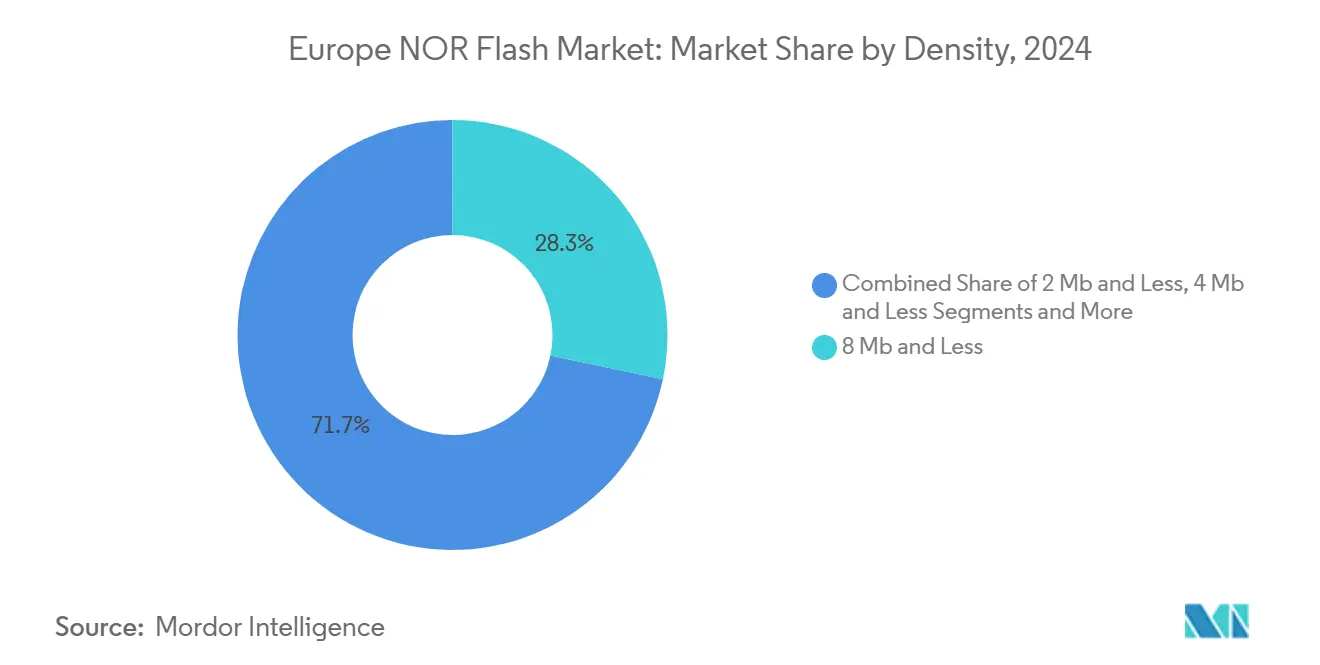
Note: Segment shares of all individual segments available upon report purchase
By Voltage Grade: 3 V entrenched; 1.8 V and 1.2 V unlock battery innovation
3 V remains the default for automotive fail-operational circuits because of noise margins and legacy design rules. It controlled 57.5% of revenue in 2024. Nonetheless, designers of wearables and sensor nodes pivot toward 1.8 V parts for energy savings, and Winbond’s debut 1.2 V NOR now cuts power consumption by 45%. The Europe NOR flash market is expected to see 1.8 V revenue outgrow every other voltage class through 2030 as medical patches and IIoT sensor hubs proliferate.
By Process Technology Node: 55 nm dominates, 28 nm and below scales performance
Mature 55/58 nm flows delivered 35.7% of 2024 revenue, striking a balance between cost and proven reliability. Infineon’s SEMPER devices tap this node while still meeting ASIL-D, ensuring risk-averse automotive purchasing managers remain comfortable.
Conversely, the 28 nm and below segment leads innovation with 5.2% CAGR. EU Chips Act co-funding of Infineon’s USD 5 billion Smart Power Fab in Dresden accelerates the domestic capability to fab sub-30 nm NOR, shrinking read latency and leakage current.
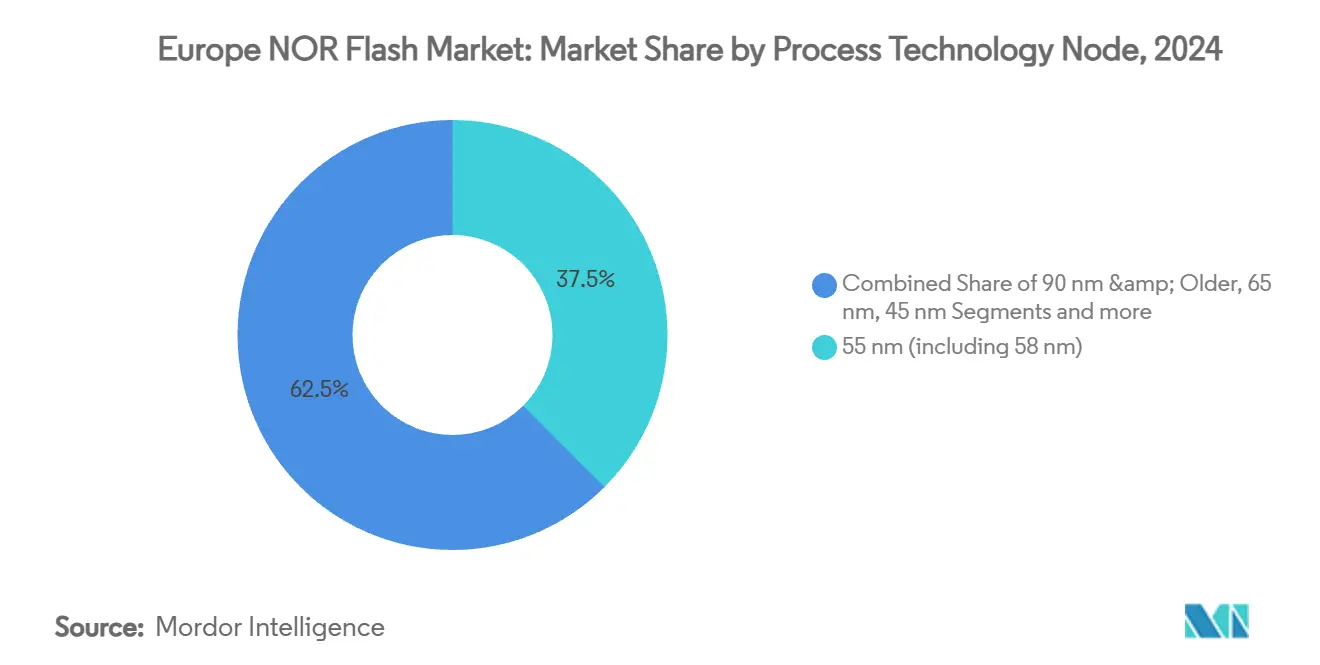
Note: Segment shares of all individual segments available upon report purchase
By Packaging Type: miniaturization shifts focus to WLCSP
QFN/SOIC captured 46.7% share in 2024 because through-hole re-flow robustness suits under-hood temperatures. Yet, as smart watches and hearing aids enter mass production, WLCSP/CSP shipments post a 5.4% CAGR. GigaDevice’s dual-voltage SPI NOR soldered straight on glass substrates demonstrates how package-on-package designs slash z-height for sleek consumer wearables.
By End-user Application: automotive retains primacy, medical accelerates
The automotive vertical dominated the market with a market share equal to 38.8% in the European NOR flash market in 2024. Regulatory pushes such as UNECE R155 cybersecurity and EU Battery Regulation favour secure-boot and authenticated OTA features that Serial NOR enables. Medical and wearables post 5.3% CAGR, propelled by EU MDR cybersecurity clauses. NXP’s EdgeLock SE05x modules integrate with external NOR to secure patient data in continuous glucose monitors [10] NXP Semiconductors, “Secure Medical IoT Application with NXP Secure Devices,” nxp.com .
Geography Analysis
Germany contributed over 20% of revenue in 2025, underpinned by ADAS leadership and Infineon’s Dresden expansion, which is co-funded with EUR 1 billion (USD 1.13 billion) public grants. German tier-1s commit to dual-sourcing NOR locally to hedge global supply shocks.
The Rest of the European countries in the Europe NOR flash market fastest-growing cluster at 5.4% CAGR. It's early 5G roll-outs and medical-device specialisation create a dual demand pathway. Finland’s wireless-module champions require low-voltage NOR for battery-operated sensors, while Sweden’s med-tech startups specify secure flash for wearables complying with MDR.
The UK faces slower expansion owing to post-Brexit customs friction that lengthens inbound supply for just-in-time automotive plants. Nonetheless, Open RAN trials with Vodafone sustain baseline demand for low-latency boot flash in baseband cards.
France remains diversified. A Crolles fab joint venture with GlobalFoundries unlocks strategic autonomy for embedded-memory flows [11] GlobalFoundries, “2023 Annual Report on Form 20-F,” gf.com . Orange’s plan to deploy only Open RAN gear by 2025 will further stimulate telecom NOR consumption.
Competitive Landscape
The Europe NOR flash market is moderately concentrated. Infineon leverages its Cypress acquisition to integrate MCUs and ASIL-D flash in a system-in-package that locks in auto OEM design-ins. The Dresden Smart Power Fab signals a localisation strategy that reduces geopolitical freight risk while winning policy support.
Macronix is pursuing product differentiation via 3D NOR, targeting mass availability by 2026 to overcome planar scaling ceilings [12] Jessie Lee, “Macronix plans inventory reduction, targets 3D NOR contribution,” digitimes.com . The move aligns with a resource-redeployment strategy, trimming low-margin bits while pivoting to high-density vertical stacks that defend ASPs.
GigaDevice executes a safety-led market-penetration play. By obtaining ISO 26262 ASIL-D for its GD25/55 Serial NOR and pairing them with automotive MCUs, the firm sharpens its value proposition to European tier-1s.
Competitive pressure also comes from substitute technologies. Everspin’s MRAM offers 500× write speed and 10× lower energy draw than NOR, positioning it as a credible disruptor in power-constrained designs [13] Everspin Technologies, “Traditional Memory vs. MRAM,” everspin.com . NOR suppliers therefore double-down on robustness and longevity niches such as functional safety, where MRAM still lacks volume qualifications.
Europe NOR Flash Industry Leaders
-
Infineon Technologies AG
-
Micron Technology Inc.
-
Winbond Electronics Corp.
-
Macronix International Co. Ltd.
-
GigaDevice Semiconductor Inc.
- *Disclaimer: Major Players sorted in no particular order
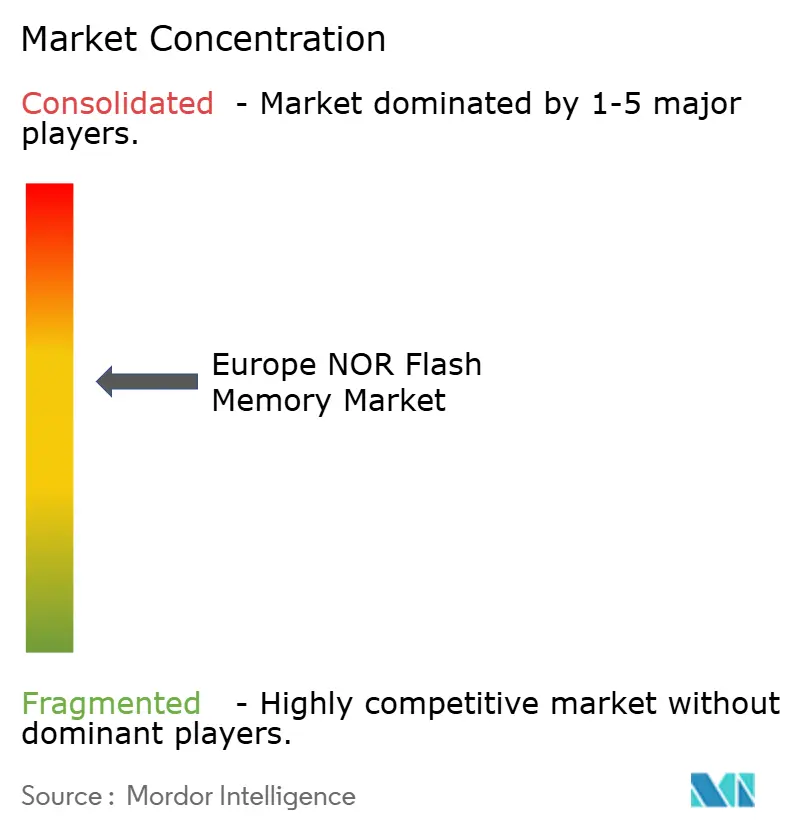
Recent Industry Developments
- May 2025: Infineon attained ASIL-D certification for its SEMPER™ family, a market-penetration move aimed at locking in automotive lifetime agreements and capturing premium price points.
- March 2025: GigaDevice unveiled GD25/55 Serial NOR and GD32A7 MCUs at Embedded World, signalling a portfolio-synergy play to cross-sell flash and controllers into the same design socket.
- February 2025: Infineon secured EU Chips Act funding for its Smart Power Fab, a capacity-expansion strategy designed to derisk supply for European customers and to internalise more value-added process steps.
- February 2025: Macronix announced inventory optimisation and accelerated 3D NOR timetable, a strategic re-alignment aimed at mitigating cyclical pricing pressure and repositioning toward higher-margin vertical stacks.
Research Methodology Framework and Report Scope
Market Definitions and Key Coverage
In this study, we define the Europe NOR flash memory market as all standalone serial and parallel NOR devices with densities above 512 Kb that are shipped to equipment manufacturers in automotive, industrial, consumer electronics, and telecom applications.
Scope Exclusion: Embedded flash blocks residing inside microcontrollers or system-on-chips are excluded to avoid double counting.
Segmentation Overview
- By Type (Value and Volume)
- Serial NOR Flash
- Parallel NOR Flash
- By Interface (Value)
- SPI Single / Dual
- Quad SPI
- Octal and xSPI
- By Density (Value)
- 2 Megabit And Less NOR
- 4 Megabit And Less-NOR (greater than 2mb) NOR
- 8 Megabit And Less (greater than 4mb) NOR
- 16 Megabit And Less (greater than 8mb) NOR
- 32 Megabit And Less (greater than 16mb) NOR
- 64 Megabit And Less (greater than 32mb) NOR
- 128 Megabit and Less (greater than 64MB) NOR
- 256 Megabit and Less (greater than 128MB) NOR
- Greater than 256 Megabit
- By Voltage (Value)
- 3 V Class
- 1.8 V Class
- Wide-Voltage (1.65 V – 3.6 V)
- Others - 1.2V Class (and similar sub-1.8V) (2.5V, 5V, etc.)
- By End-user Application (Value and Volume)
- Consumer Electronics
- Communication
- Automotive
- Industrial
- Other Applications
- By Process Technology Node (Value)
- 90 nm and Older
- 65 nm
- 55 nm (including 58 nm)
- 45 nm
- 28 nm and Below
- By Packaging Type (Value)
- WLCSP / CSP
- QFN / SOIC
- BGA / FBGA
- Others
- By Country
- Germany
- United Kingdom
- France
- Italy
- Rest of Europe
Detailed Research Methodology and Data Validation
Primary Research
To verify desk findings, we interviewed application engineers, franchised memory distributors, and purchasing leads in Germany, the United Kingdom, France, and Italy. Their views on shipment discounts, automotive-grade premiums, and buffer stock practices helped us fine-tune assumptions and close information gaps.
Desk Research
Mordor analysts first mapped the landscape using open sources such as Eurostat import code HS 854232, World Semiconductor Trade Statistics regional sales, and the German Motor Transport Authority's electronics tables; these datasets reveal unit inflow, density shifts, and price erosion across Western and Central Europe. We then added insight from IEEE Xplore papers on xSPI adoption, patent trends captured on Questel, and financial splits from D&B Hoovers and Dow Jones Factiva to frame supplier exposure.
We also reviewed company filings, trade press interviews, SEMI's fab capacity tracker, and key association briefs, which together clarified supply swings and demand pockets. The references listed are illustrative only; many additional sources were consulted for data collection, cross-checks, and clarification.
Market-Sizing & Forecasting
We start with a top-down reconstruction that aligns Eurostat import value and WSTS regional sales with net OEM consumption after channel markdown factors. The output is tested against a sampled bottom-up roll that multiplies distributor volume disclosures by blended selling prices. Key model levers include yearly light vehicle production, industrial robot installs, the serial to parallel mix shift, and process node driven cost decline. A multivariate regression supported by ARIMA smoothing projects the market through 2030, while missing density data points are bridged with moving averages of adjacent brackets.
Data Validation & Update Cycle
Model outputs pass variance checks, scenario stress tests, and a two-level analyst review before sign-off. We refresh each study every twelve months, and analysts issue interim updates when events such as fab outages or major design wins materially alter demand.
Why Mordor's Europe NOR Flash Baseline Is Dependable
Published values often differ because firms vary device scope, pricing sources, and refresh cadence.
Some publishers merge embedded code storage or even NAND into one flash figure; others rely on list prices without distributor discounts, and a few project demand using aggressive automotive unit curves. Mordor keeps a narrowly defined standalone NOR lens, updates annually, and grounds every assumption in live distributor inputs, which tempers extremes.
Benchmark comparison
| Market Size | Anonymized source | Primary gap driver |
|---|---|---|
| USD 1.37 B (2025) | Mordor Intelligence | |
| USD 3.38 B (2025) | Regional Consultancy A | Includes embedded MCU flash and omits channel discounts |
| USD 3.90 B (2025) | Industry Association B | Combines NAND with NOR and uses list price ASPs |
Once scope and pricing filters align, we believe Mordor's figure offers a balanced, transparent baseline that decision makers can trace back to clear variables and repeatable steps.
Key Questions Answered in the Report
What is the current size of the Europe NOR Flash market?
The market is valued at USD 544.33 million in 2025 and is projected to reach USD 676.65 million by 2030.
Which segment is growing fastest within the Europe NOR Flash market?
High-density devices above 256 Mb post the highest 3.6% CAGR as software-defined vehicles demand secure, large code storage.
Why are Octal and xSPI interfaces gaining traction?
They provide up to 500 MB/s read throughput while retaining PCB simplicity, making them ideal for ADAS and infotainment controllers.
How does the EU Chips Act influence supply security?
Funding accelerates local fab capacity at 28 nm and 45 nm, reducing dependence on overseas suppliers for automotive-grade flash.
What competitive threat does MRAM pose?
MRAM offers faster writes and lower energy, challenging NOR in power-sensitive designs; however, NOR retains an advantage in long-term data retention and functional safety certifications.
Which country leads consumption of Europe NOR Flash market products?
Germany holds the top spot with a 22.8% revenue share, supported by its robust automotive and industrial automation ecosystems.
Page last updated on:
